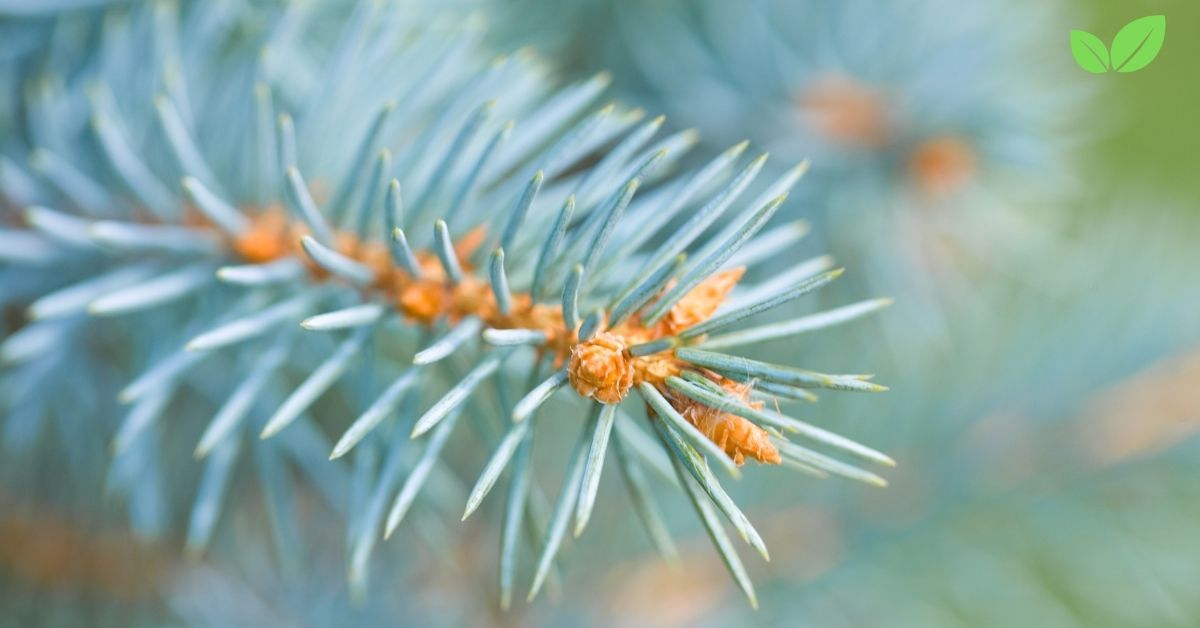Introduction
The blue spruce (Picea pungens) is an iconic coniferous tree native to North America, particularly the Rocky Mountain region. Known for its striking blue-green foliage and symmetrical growth, the blue spruce is highly valued both for its aesthetic appeal and its ecological significance. This tree has adapted to thrive in mountainous environments with harsh climatic conditions, making it a symbol of resilience and natural beauty. While the blue spruce is commonly planted as an ornamental tree in landscapes and gardens, its role in natural ecosystems is profound, as it contributes to biodiversity, wildlife habitat, and ecosystem services such as carbon sequestration.
In this article, we will explore the environmental niche of the blue spruce, delving into its ecological importance, its role in forest ecosystems, its interactions with wildlife, and its adaptability to climate change. Furthermore, we will examine the conservation challenges this species faces due to threats like habitat loss, climate change, and pest infestations.
Blue Spruce: An Overview
The (Picea pungens), also known as the Colorado spruce, is a slow-growing, long-lived tree that can reach heights of 30 to 75 feet in the wild, although some individuals have been known to grow even taller. The tree is characterized by its rigid, needle-like leaves that range in color from blue-green to silvery-blue, depending on environmental factors and genetic variation. The blue spruce is one of the most cold-tolerant conifers, capable of thriving at altitudes of 6,000 to 11,000 feet in its native range.
This tree is most commonly found in subalpine regions, where it grows alongside other coniferous species like Engelmann spruce, lodgepole pine, and subalpine fir. The blue spruce is well adapted to withstand harsh winter conditions, frequent snowfall, and strong winds, making it a key species in high-elevation forests.

Characteristics of Blue Spruce
The (Picea pungens) has several distinctive characteristics that set it apart from other conifer species. Its rigid, sharp needles are arranged radially around the branches, giving the tree its full, symmetrical appearance. These needles can range from 1 to 1.5 inches in length and have a waxy coating, which helps reduce water loss and protect the tree from extreme cold.
The bark of the blue spruce is thin and scaly in young trees, gradually becoming thicker and more furrowed as the tree matures. This bark provides protection against fire, insects, and diseases, although the (Picea pungens) is not immune to these threats.
Blue spruces produce cones that are about 2.5 to 4 inches long, with flexible scales that open to release seeds. These seeds are an important food source for birds and small mammals, further cementing the tree’s role in its ecosystem.
Ecological Niche of the Blue Spruce
The blue spruce occupies a vital ecological niche in the forest ecosystems of the Rocky Mountains and other high-elevation regions of North America. As a keystone species, it provides essential services to the environment, from creating habitat for wildlife to influencing soil and water cycles. In this section, we will examine the blue spruce’s role in its ecosystem and how it contributes to the stability and biodiversity of its environment.
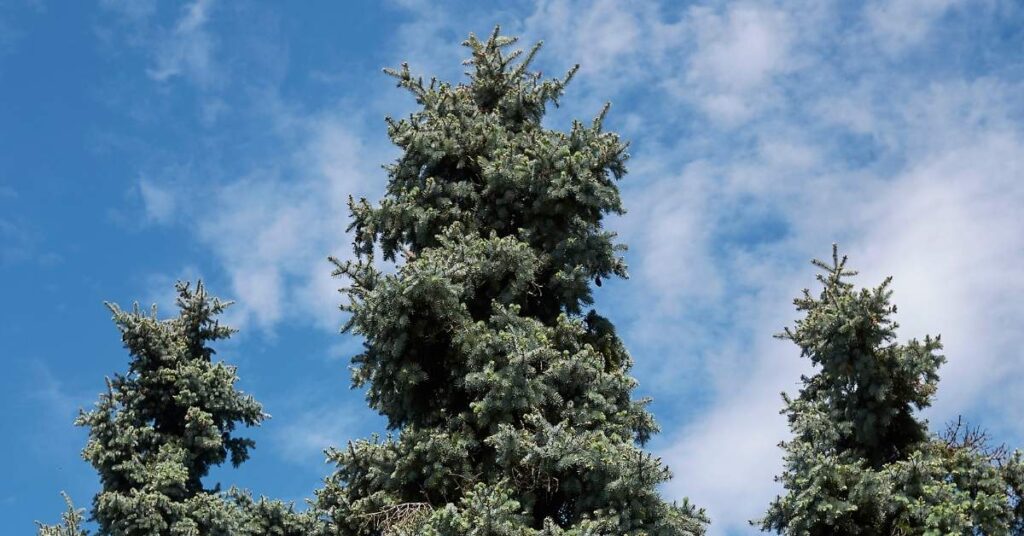
Habitat and Range
The blue spruce is primarily found in the central and southern Rocky Mountains, ranging from Wyoming and Colorado to Utah and New Mexico. It thrives in moist, well-drained soils along mountain slopes, valleys, and riverbanks. In these habitats, the blue spruce often grows in mixed coniferous forests, where it coexists with other species that can tolerate cold, dry conditions. The tree prefers full sunlight but is capable of surviving in partial shade, making it a versatile species in the forest canopy.
The blue spruce is highly adaptable to varying soil types, including sandy, loamy, and clay soils, although it prefers slightly acidic conditions. It can tolerate drought better than many other conifers due to its deep root system, which allows it to access water from deeper soil layers.
Water and Nutrient Cycling
As a long-lived conifer, the (Picea pungens) plays a crucial role in water and nutrient cycling within its ecosystem. Its deep root system helps stabilize soil and prevent erosion on mountain slopes, particularly in areas prone to landslides or heavy rainfall. By anchoring the soil, blue spruces help maintain the integrity of the landscape, protecting the forest floor from degradation.
The tree’s needles and cones contribute to the nutrient cycle as they fall to the forest floor and decompose. This process returns vital nutrients like nitrogen and phosphorus to the soil, promoting the growth of other plant species. Additionally, the thick canopy of the blue spruce helps reduce surface runoff by intercepting rainfall and snowmelt, allowing water to be absorbed gradually into the soil and preventing flooding.
Carbon Sequestration and Climate Regulation
One of the most important ecological functions of the (Picea pungens) is its ability to sequester carbon dioxide from the atmosphere. As a slow-growing, long-lived tree, the blue spruce stores large amounts of carbon in its wood, needles, and roots over its lifetime. This makes it an important species for climate regulation, as it helps mitigate the impacts of climate change by reducing the concentration of greenhouse gases in the atmosphere.
In addition to sequestering carbon, (Picea pungens) forests contribute to local climate regulation by providing shade and cooling the surrounding environment. The tree’s dense canopy reduces the amount of sunlight that reaches the forest floor, helping to moderate temperatures and create a stable microclimate for other species.
Wildlife Interactions with Blue Spruce
The (Picea pungens) provides critical habitat and food for a wide range of wildlife species. Its towering branches offer shelter for birds, mammals, and insects, while its seeds and needles serve as a food source for various animals. In this section, we will explore the different ways in which wildlife interacts with blue spruce trees and how these interactions contribute to the overall health of the ecosystem.
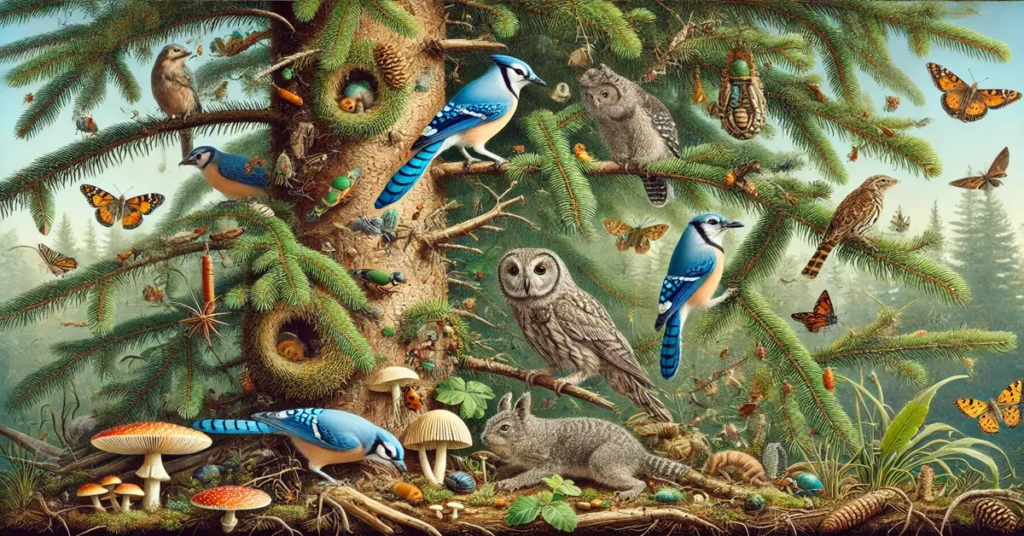
Birds and Mammals
The blue spruce is an important resource for many bird species, particularly those that rely on coniferous forests for nesting and foraging. Species such as the red-breasted nuthatch, pine siskin, and Clark’s nutcracker often build their nests in the branches of blue spruce trees, where they are protected from predators and the elements. These birds also feed on the seeds produced by (Picea pungens) cones, which provide a valuable source of energy during the winter months when other food sources are scarce.
Small mammals, such as squirrels and chipmunks, also benefit from the blue spruce’s seed production. These animals often cache (Picea pungens) seeds in the ground, which helps with seed dispersal and regeneration of new trees. Additionally, larger mammals like deer and elk may seek shelter in the dense foliage of blue spruce trees, particularly during harsh winter conditions.
Insects and Pollinators
While conifers like the (Picea pungens) are not typically associated with pollinators in the same way that flowering plants are, they do support a variety of insect species that play important roles in the ecosystem. Insects such as bark beetles, wood-boring beetles, and aphids feed on the needles, bark, and wood of blue spruces. Although these insects can cause damage to individual trees, they are part of the natural cycle of forest ecosystems and help recycle nutrients by breaking down plant material.
Certain species of moths and butterflies also rely on blue spruces as host plants for their larvae. For example, the larvae of the spruce budworm feed on the needles of (Picea pungens), which can lead to defoliation during outbreaks. However, these larvae are also an important food source for birds and other predators, creating a complex web of interactions within the forest.
Mycorrhizal Fungi and Soil Health
The blue spruce has a symbiotic relationship with mycorrhizal fungi, which form mutualistic associations with the tree’s roots. These fungi help the tree absorb water and nutrients from the soil, particularly phosphorus, in exchange for carbohydrates produced by the tree through photosynthesis. This relationship enhances the blue spruce’s ability to thrive in nutrient-poor soils, making it more resilient to environmental stressors.
Mycorrhizal fungi also play a critical role in soil health by improving soil structure, increasing nutrient availability, and promoting the growth of other plant species. The presence of these fungi in (Picea pungens) forests contributes to the overall health and productivity of the ecosystem.
Adaptations of the Picea Pungens to Harsh Environments
The blue spruce has evolved several key adaptations that allow it to survive in the harsh, high-altitude environments where it is commonly found. These adaptations include its cold tolerance, water conservation mechanisms, and ability to thrive in nutrient-poor soils. In this section, we will examine the specific adaptations that enable the (Picea pungens) to thrive in its challenging habitat.
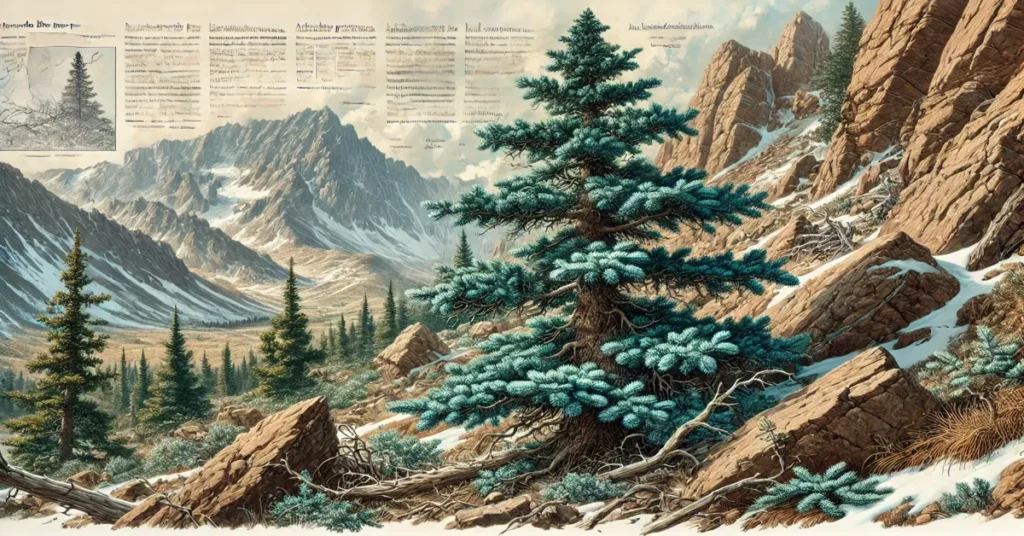
Cold Tolerance
One of the most notable adaptations of the (Picea pungens) is its ability to withstand extremely cold temperatures. The tree’s needles are coated with a thick layer of wax, which helps reduce water loss through transpiration during the winter months. This waxy coating also protects the needles from freezing by preventing ice crystals from forming on their surface.
In addition to its waxy needles, the blue spruce has developed a deep root system that allows it to access water even when the surface soil is frozen. This enables the tree to continue taking in moisture and nutrients during periods of freezing temperatures, ensuring its survival in cold climates.
Drought Resistance
While the blue spruce is commonly found in moist environments, it is also capable of surviving periods of drought thanks to its deep roots and water-conserving adaptations. The tree’s needle-like leaves have a small surface area, which reduces the amount of water lost through evaporation. Additionally, the waxy coating on the needles helps prevent water loss, allowing the tree to conserve moisture during dry spells.
This drought-resistance makes the (Picea pungens) particularly well-suited to the dry, high-altitude environments of the Rocky Mountains, where water availability can be limited. In these regions, where precipitation is often sparse and erratic, the blue spruce’s ability to retain water and access deeper soil moisture gives it a competitive advantage over other species. This adaptation also allows the tree to survive in areas where seasonal droughts occur, making it a resilient and essential species in its natural habitat.
Nutrient Efficiency
The (Picea pungens) has adapted to thrive in nutrient-poor soils, a characteristic of many high-altitude environments. The symbiotic relationship between blue spruce roots and mycorrhizal fungi plays a key role in this adaptation. These fungi extend the tree’s root network by forming a network of fine filaments, or hyphae, which penetrate the soil and help the tree absorb nutrients that would otherwise be inaccessible. In exchange for providing the tree with essential nutrients such as phosphorus, the fungi receive carbohydrates produced by the tree during photosynthesis.
This nutrient-efficient strategy allows the blue spruce to thrive in soils that lack the rich organic material often found in lower-altitude forests. As a result, the tree can grow in areas where other species may struggle to survive, further highlighting its resilience and adaptability.
Blue Spruce in Human Culture and Industry
While the ecological importance of the (Picea pungens) cannot be overstated, the tree has also played a significant role in human culture and industry. Its wood, medicinal properties, and aesthetic value have made it a key resource for indigenous peoples, settlers, and modern industries alike. In this section, we will explore the cultural and economic significance of the blue spruce, both historically and in contemporary society.
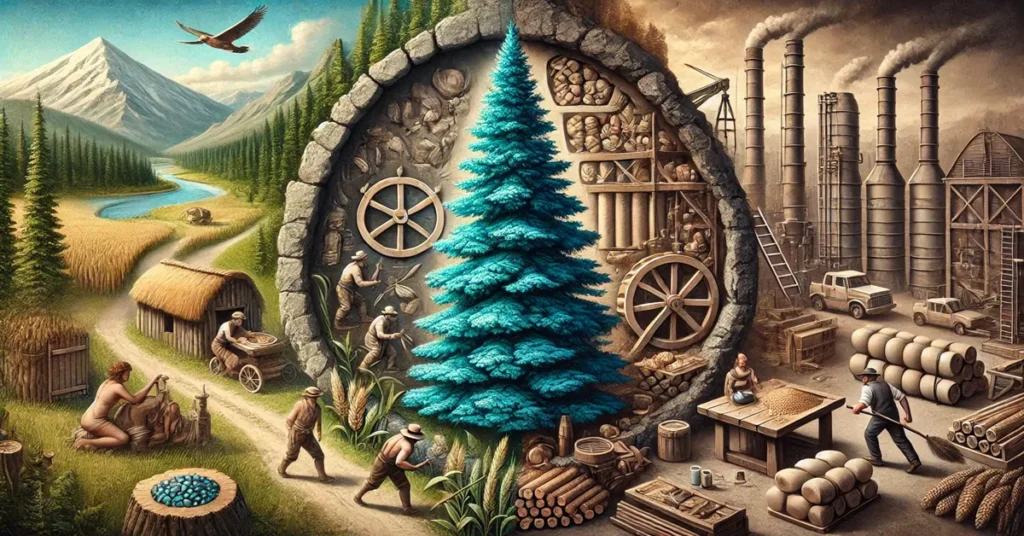
Traditional Uses of Blue Spruce
For indigenous peoples of North America, the (Picea pungens) has long been a valuable resource for a variety of practical and ceremonial purposes. The tree’s wood was used to construct shelters, tools, and even ceremonial items due to its strength and durability. Blue spruce bark and sap were also used in traditional medicine to treat various ailments, including coughs, colds, and skin infections. The resin from blue spruce trees was often used to make salves and poultices that could be applied to wounds to promote healing.
In addition to its practical uses, the blue spruce held spiritual significance for some indigenous cultures. The tree’s strength and resilience in harsh environments were seen as symbolic of endurance and survival, qualities that were often revered in the cultural traditions of the Rocky Mountain region.
Blue Spruce in Modern Industry
Today, blue spruce wood is valued for its strength and versatility. It is commonly used in construction, particularly for framing, flooring, and paneling. Its fine grain and resistance to decay make it ideal for use in both indoor and outdoor applications. However, due to its relatively slow growth rate, blue spruce is not as widely used as some other coniferous species, such as pine or fir, in large-scale commercial forestry.
The blue spruce is also highly prized as an ornamental tree, particularly in landscaping and horticulture. Its striking blue-green foliage and symmetrical growth pattern make it a popular choice for parks, gardens, and urban landscapes. Blue spruce trees are often planted for their aesthetic appeal, and their ability to tolerate a wide range of soil and climate conditions makes them a versatile option for homeowners and landscapers.
The Blue Spruce as a Christmas Tree
One of the most well-known uses of blue spruce is as a Christmas tree. Its symmetrical shape, vibrant blue-green needles, and strong branches make it a popular choice for holiday decorations. In fact, blue spruce trees are commonly grown on Christmas tree farms and are sold as live or cut trees during the holiday season. The tree’s sturdy branches can support heavy ornaments, and its relatively long-lasting needles make it a practical option for families who want a Christmas tree that will stay fresh throughout the season.
Conservation Challenges Facing the Blue Spruce
While the blue spruce is a resilient species, it faces several conservation challenges that threaten its long-term survival. Habitat loss, climate change, pest infestations, and disease are all contributing factors to the decline of blue spruce populations in certain regions. In this section, we will discuss these challenges in detail and explore the efforts being made to protect and conserve blue spruce trees and their ecosystems.

Habitat Loss and Fragmentation
As with many tree species, habitat loss and fragmentation pose significant threats to blue spruce populations. Urban development, agriculture, and deforestation have all contributed to the reduction of blue spruce habitats, particularly in lowland areas where the tree is sometimes found outside its typical high-altitude range. The fragmentation of forests can isolate blue spruce populations, reducing genetic diversity and making the trees more vulnerable to environmental stressors such as disease and climate change.
The loss of habitat also has broader implications for the ecosystems in which blue spruce trees are found. As a keystone species, the blue spruce provides critical habitat and food for a wide range of wildlife. When blue spruce populations decline, the species that depend on them for survival may also suffer.
Climate Change
Climate change is one of the most significant challenges facing the blue spruce today. As temperatures rise and precipitation patterns shift, the high-elevation environments where blue spruce trees thrive are changing. Warmer temperatures and reduced snowpack can lead to drought conditions, which stress the trees and make them more susceptible to pests and diseases.
In addition to the direct impacts of climate change, shifting climate zones may force blue spruce trees to migrate to higher elevations or more northern latitudes to survive. However, this migration is often hindered by habitat fragmentation, human development, and other barriers. If blue spruce populations are unable to migrate or adapt to changing conditions, they may face significant declines in the future.
Pests and Diseases
Several pests and diseases pose a threat to blue spruce trees, particularly in regions where the trees are already stressed by drought or other environmental factors. One of the most concerning pests is the spruce beetle (Dendroctonus rufipennis), which has caused widespread damage to blue spruce populations in parts of North America. These beetles bore into the tree’s bark, disrupting the flow of water and nutrients and ultimately killing the tree.
Another major threat to blue spruce is Rhizosphaera needle cast, a fungal disease that causes the tree’s needles to turn brown and drop prematurely. While this disease does not typically kill mature trees, it can weaken them over time, making them more susceptible to other stressors such as drought and pests.
Conservation Efforts
Conservation efforts aimed at protecting blue spruce populations focus on preserving and restoring their natural habitats, combating pest infestations and diseases, and mitigating the effects of climate change. In national parks and protected areas where blue spruce trees are found, forest management practices such as controlled burns, pest management, and reforestation are being used to maintain healthy forest ecosystems and prevent the spread of invasive pests and diseases.
Additionally, efforts to conserve blue spruce genetic diversity are underway. Seed banks and tree nurseries are working to preserve the genetic material of blue spruce populations, which can be used to restore degraded habitats and ensure the species’ survival in the face of environmental challenges.
Conclusion
The blue spruce is not only a beautiful and resilient tree but also an essential component of the ecosystems in which it is found. Its ability to thrive in harsh, high-altitude environments, combined with its role in water and nutrient cycling, wildlife habitat, and carbon sequestration, makes it a keystone species in the forests of the Rocky Mountains and beyond.
However, like many species, the blue spruce faces significant challenges from habitat loss, climate change, pests, and diseases. By understanding the environmental niche of the blue spruce and its ecological importance, we can better appreciate the need to protect and conserve this remarkable tree for future generations.
Through a combination of habitat preservation, forest management, and climate adaptation strategies, we can help ensure that blue spruce populations continue to thrive in their natural habitats. As we confront the environmental challenges of the 21st century, the blue spruce stands as a symbol of resilience and adaptability—a reminder of the importance of preserving our natural world.
Read More: Is White Spruce Safe to Make Tea With in Alaska? A Comprehensive Environmental Guide

